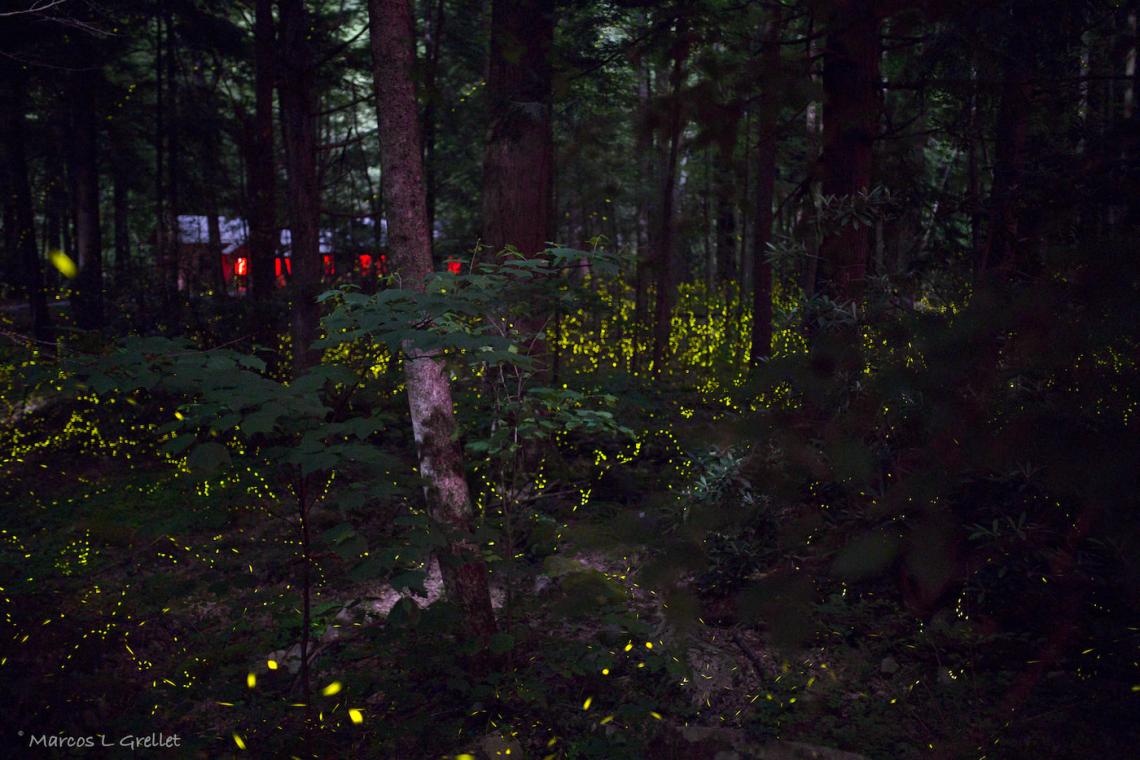Against an intensely luminous city backdrop, stars and fireflies faint throughout skies and forests, leaving emptiness in their wake. The wild Smoky Mountains National Park, Tennessee, provides the ideal surroundings to escape the light and view the fireflies show.
The cab stopped at the forest entrance, a gravel road that crept into the thickness of the woods. "Good luck," wished the man who picked me up from Knoxville airport and was now dropping me off at Elkmont Campground, on the edge of the Smoky Mountains National Park between North Carolina and Tennessee — USA. His wish was sincere. He seemed upbeat about the possibility that, over the next few days, I would manage to photograph fireflies and their hypnotic synchronization. I was alone and overloaded with all sorts of equipment: a tent, sleeping bag, waterproof everything, camera, all types of lenses, tripod, clothes, bear spray, dehydrated food, and plenty of sugary bars. That's how some adventures ensue: in some, you lose weight; in others, you compensate by returning to civilization with diabetes and some tendinitis.
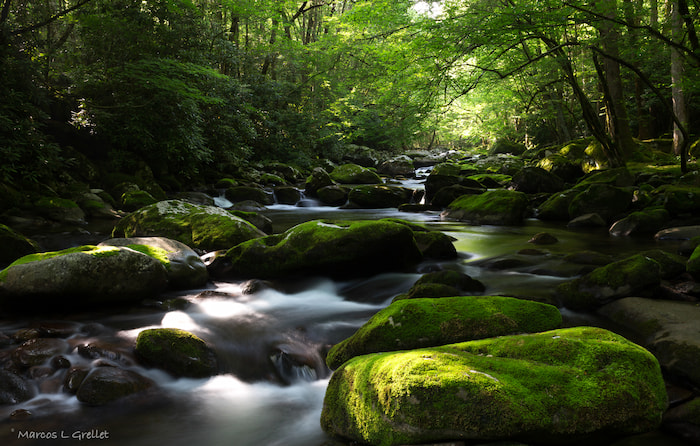
Into the Wilderness: The Journey to the Smoky Mountains National Park
As one foot left the asphalt, the other seemed reluctant, momentarily lagging behind. I was born this way; one foot was always braver than the other. One always led the way, while the other seemed fearful to follow. A nine-kilometre-long hiking trail lay ahead of the campsite, winding along a river that was neither full nor empty. As I walked, my mind constantly returned to the unsettling weather forecast the taxi driver had told me about; “tonight a once in a lifetime storm is predicated to sweep across the mountains.” At least this distracted me from thinking about the many black bears that make their home – and the occasional banquet – in the park, the latter of which may or may not include tourists.
At night, settled in my campsite, eerily deserted, sounds of thunder shattered the black sky, making way for lightning that illuminated the treetops. Then came the wind, and branches began to fall around me. Soon after, raindrops that seemed to have swallowed entire pools flooded the forest. It was the folklore of the heavens coming to play over my head. Unexpectedly, what I couldn’t hear frightened me the most: the cacophony of the forest silenced the sneaky approach of a hungry bear. It was such a disaccord of noises that the sheer amount of it made me deaf.
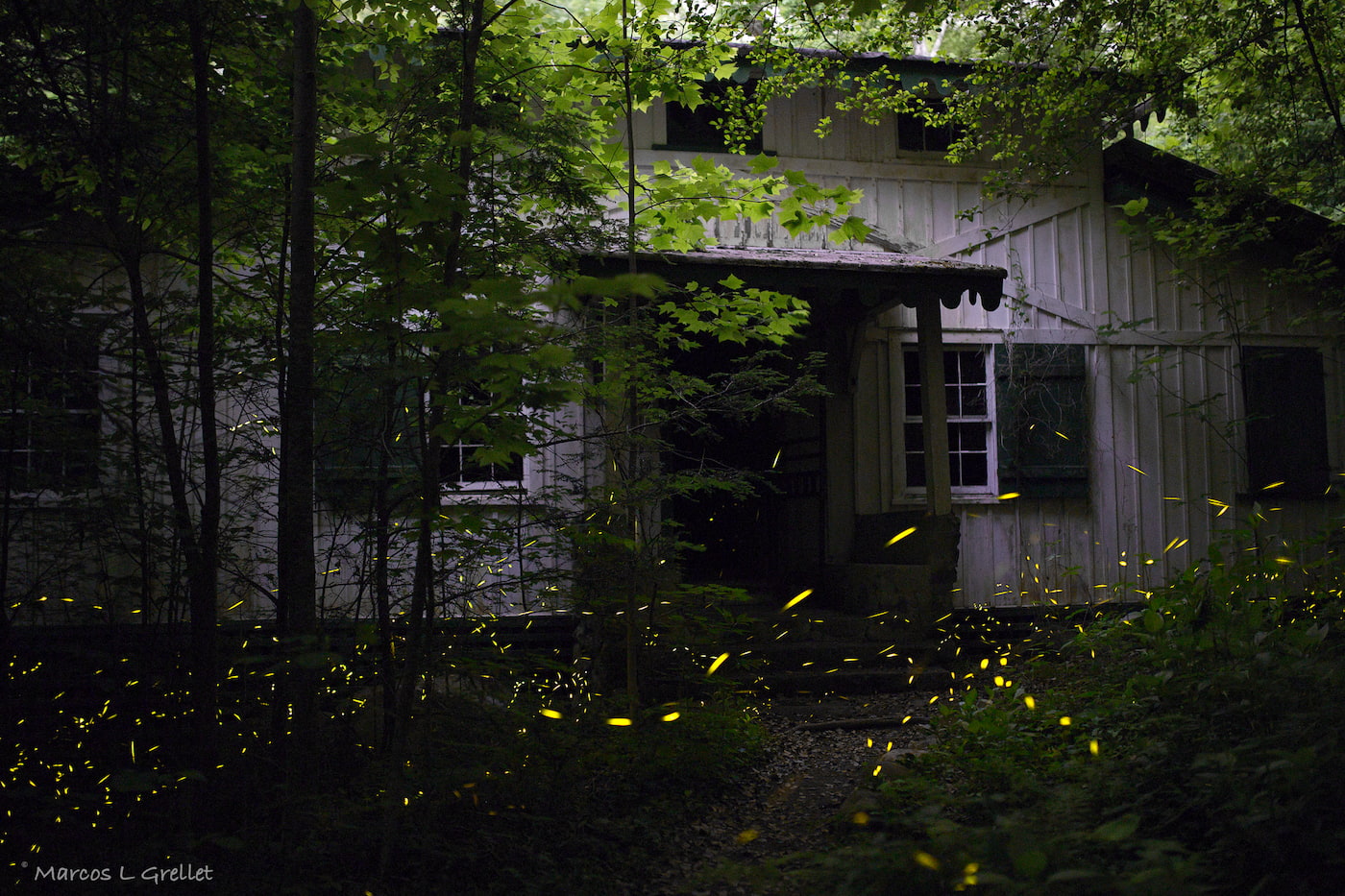
The night dragged on endlessly, neither asleep nor awake, eventually bringing the morning surrounded in humidity and birds remarkably animated – it hadn’t been easy for anyone, I guessed. With heavy eyes and my skin covered in sweat and fear, I went down to the river to cleanse myself of the night's tension. As I entered the rain-soaked current, I felt the full force of the storm seeping through the waters. It was as if the electricity of the lightning, the noise of the thunder, and the soreness of broken branches ran through the river. They were the lines of nature running past my body.
Time and again, a somewhat authoritative whistle sounded in the distance. If it was a carnival, the evening was not promising. Yet, walking along the path I took the day before to Elkmont campground, dodging an apprehensive crowd, I saw park rangers using whistles to organize the flow of people and direct our attention to the “Do’s & Don’t”. Beach chairs, a camera tripod, and thermal bottles were allowed; reserving a spot, catching fireflies, and drinking alcohol were not. At the entrance to the trail, other guards checked to see if the flashlights had red cellophane paper taped over the bulb — many insect species are less sensitive to red light because their visual systems are not well-equipped to detect longer wavelengths, as is the case with red light. If not, they donated the paper and a rubber band, reminding visitors that the flashlight was meant to illuminate the path, not the display. Gradually, everyone found a place to stand or sit amidst the trees, and the evening found the forest.
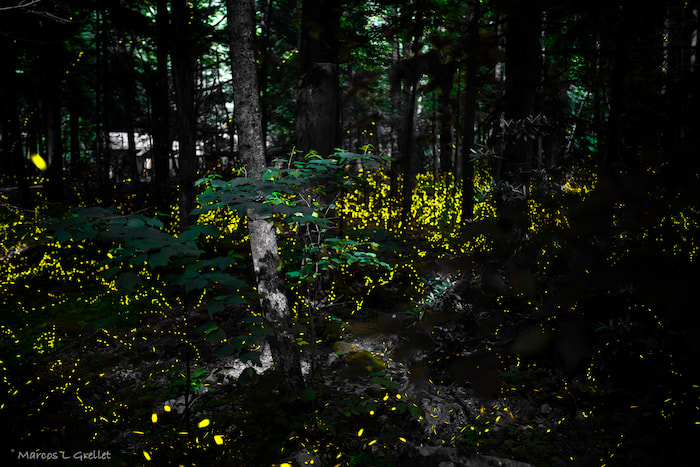
Enchanting Dance: The Fireflies' Synchronized Light Show
In the space left by the last rays of sunset, a light flashed so briefly that it seemed intimidated by the forest's darkness. Then, another blinked quickly to the left. One more on the right. Then, there was another one in the background, followed by several others. And another. And others more. And like clouds that come together to cascade in the rain, at the end of fifteen minutes, the entire forest floor is lit up in a greenish yellow by thousands of male fireflies —Photinuns Carolinus — in search of a female. Seemingly undecided of where and when to blink, some sought higher vegetation, flashing and flickering. Others flew at mid-height along the tree line. Randomly sparkling and twinkling. Glittering. All around.
Uncoordinated.
A hesitation seized the air. People’s expressions appeared disappointed. They seemed to be searching for a T-Rex or something more majestic than fireflies. The river could be heard, and nothing else. People seemed observant but not necessarily pleased. They wanted more than the fireflies show. And soon, thirty minutes after the last ray of sunlight had faded, the thousands and thousands of fireflies blinking all over the place suddenly synchronized the intermittences of light. They flickered on and off at the same tempo, with the same intensity, at precisely the same time. What was once a forest randomly dotted with a tiny, luminous insect became an ecstatic light concert. The air trapped in people’s lungs gave way and crumbled on top of itself. No one dared to exhale.
By the thousands and throughout the forest, the males blinked with precision, throbbing eight times at half-second intervals between each pulse. A few females of the same species, concealed by vegetation, would counter three seconds later with two succinct, almost ‘blasé’ pulses, saying between the lines that they were interested in one male or another. A few minutes later, as the competition became increasingly fierce, darkness was again shattered by the same vastness of eight male pulses with half-second intervals between each. The desire is so great that the synchronization lasts three hours.
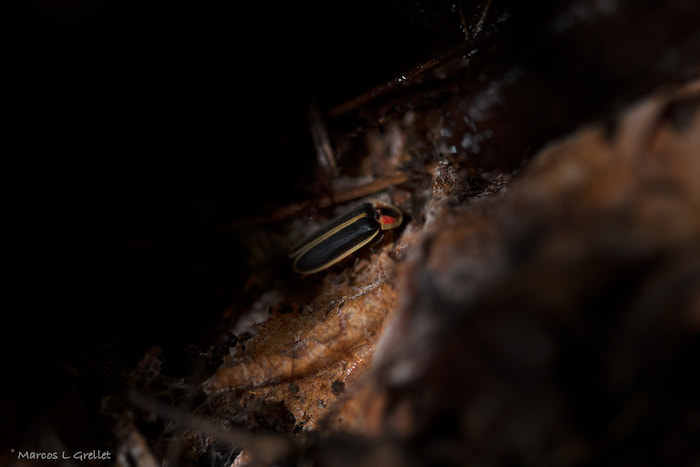
Bioluminescent Wonders: Unveiling the Secret Lives of Fireflies
In the end, the males that emit the most intense and best-synchronized pulse will be selected by the females for mating. "It is one of many examples of the complex communication between fireflies," explains Professor Dr. Vadim Viviani from the Federal University of São Carlos, Brazil, where he coordinates numerous projects associated with the investigation of bioluminescence, luciferase enzymes, biological chemiluminescence, and their biotechnological and environmental use.

With a wide variety of species, fireflies (used in this text in very general terms) are bioluminescent beetles belonging to three main families: (i) Lampyridae family — commonly known as ‘fireflies’ or ‘lightning bugs,’; (ii) Elateridae — also known as ‘click beetles’ or ‘skipjacks’, for their ability to jump or ‘click’ when they are on their backs; and (iii) Phengodidae —'glowworm beetles’. Like all beetles, they go through a complete metamorphosis during their lives: egg, larva, pupa, and adult. After mating, the females lay hundreds of eggs under the humidity of wetland soils, where after three to four weeks, the eggs hatch in late summer in larval form, whereupon many species are bioluminescent, albeit in the adult phase, many are not. During the larval stage, which lasts one to two years, depending on the species, the larvae feed mainly on snails, slugs, worms, and small insects. When ready for pupation, usually in late spring, they burrow themselves under the ground or attach themselves to leaves and begin their metamorphosis. About ten days later, the adult firefly emerges with one purpose: to reproduce.
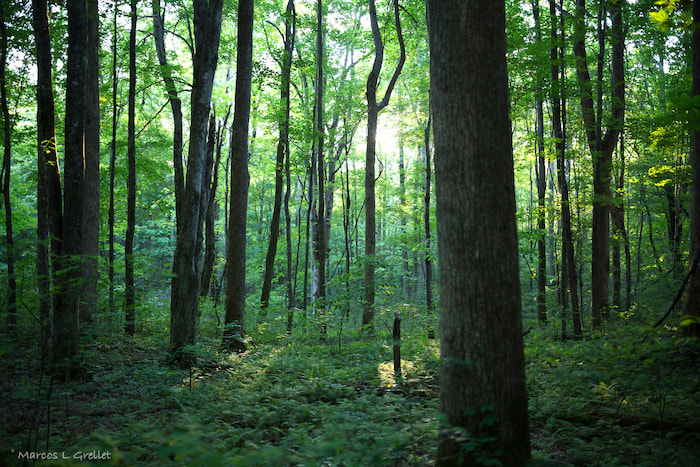
Beyond the Blink: The Science and Splendor of Firefly Illumination
The light emitted by the firefly is the result of a biochemical reaction that occurs inside so-called ‘photocytes’ cells. In simple terms, certain substances in living cells can produce light when they react chemically. This process involves the interaction of four things: oxygen, adenosine triphosphate (ATP), a special enzyme called 'luciferase', and a fuel called 'luciferin'. The energy stored in ATP is used to power the reaction, catalyzed by luciferase to produce the light emission. The process occurs inside organs called ‘flashlights’: using the energy stored in the ATP molecule, the neurotransmitter activates the luciferase enzyme, and once oxygen is added to the mix, the luciferin molecule is oxidized. This process, in turn, produces carbon dioxide and a new oxyluciferin molecule in a fluorescent state. In other words, light!
"Contrary to popular belief, recent studies indicate that the light efficiency — a measure of how efficiently a light source produces usable light while minimizing energy waste — of the fireflies ranges between 61% for the most efficient species to 40% percent for the least efficient," explains Viviani. When this is compared to other light sources, “such as the fluorescent or incandescent lamp,” with a light efficiency of 25% and 15%, respectively, “we can notice how effective light production is in fireflies.” The ability to glow serves many purposes and helps fireflies communicate with different organisms: to the larvae, which are all luminescent, light is helpful to warn potential predators that they possess a toxin that is not only unpalatable but also harmful to digestion and for some species of larvae (i.e. Pyrearinus termitilluminans), which infest abandoned termite mounds in central Brazil, the use of bioluminescence serves to attract small winged insects to feed on.
Adults, on the other hand, use bioluminescence for distinction, attraction, and courtship in the early stages of reproduction; as a defence by flashing intensely, distracting the predator; to seek and attract prey, as in the case of the female of the species Photuris that impersonate luminous patterns of another species to prey on an unsuspecting male who is misled to think that night is won; and finally, for illumination. While there is no concrete evidence for the latter, "there are strong indications that the abdominal lantern serves some species of fireflies from landing in dangerous places by illuminating the vegetation,” explains Viviani.
By studying the biological and biochemical wonders of fireflies, scientists developed innovative ways to apply similar reactions to benefit humans. For instance, “cloning of the luciferase genes” has served “numerous biological-molecular applications of biotechnological and biomedical interest by using them as optical biomarkers,” explains Professor Viviani. Using the luciferase gene, researchers can tag cells, including human cells, to express bioluminescent properties. “When we tag a cancer cell of a primary tumor,” notes Viviani, “we can follow the metastasis within the body, meaning the dispersal of cancer cells that detach from the primary tumor and enter the bloodstream or lymphatic system and spread to different organs.” By following the cancerization process via bioluminescent markers, researchers can verify the efficacy of anticancer drugs more effectively: the smaller the number of luminescent cells, the better the effect of the drug.
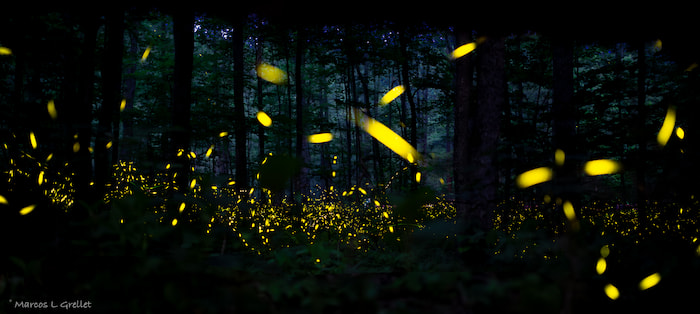
Prior to its use in genetics, the biochemical reaction of fireflies has been employed to monitor the existence of biological activities and bacterial contamination in food. According to Viviani, "[s]ince every cell has ATP (indispensable in the bioluminescent reaction of fireflies), the food industry uses the same chemical principles to monitor the quality and hygiene of products by tagging some food with genes of the enzyme luciferase, which, when fluorescent, indicate that it is tainted, since the luminescence signals that there are active bacteria in the food, after all, every active organism has ATP."
Lighting the Path: Fireflies as Environmental Indicators
Due to the diversity of habitats in which fireflies live and their sensitivity to environmental factors, they are used by researchers as bioindicators of environmental impacts. “A biological bioindicator is precisely what the name suggests: an indicator of the state of an ecosystem or of an impact based on the sampling of a particular group. The firefly not only indicates whether it is present but can also provide clues to the quality of the habitat or the existence of an impact," notes Viviani. Researchers have been working with firefly entomologists using aquatic larvae as bioindicators in Japan, where the government is trying to recondition some rivers and streams. An excess of fireflies in a particular area can also indicate an imbalance in the ecosystem. One species, for example, appears in excess where there are a lot of cattle; the manure flowing into rivers feeds snails, which in turn are the main prey of this firefly species.
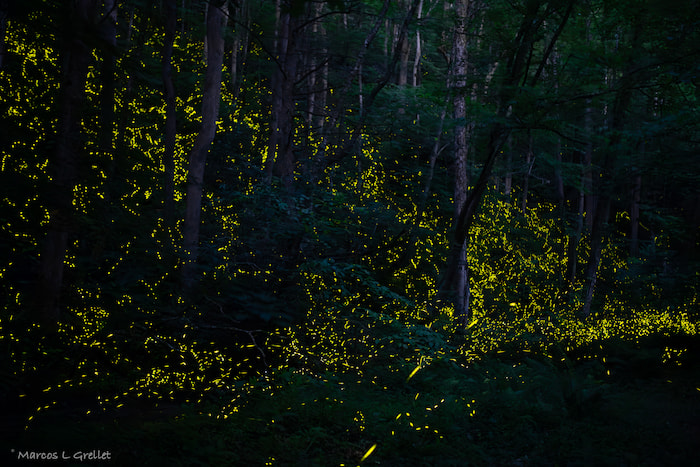
Preserving Darkness: Battling Light Pollution in Firefly Habitats
With our ancestral and innate fear of the dark, we have polluted our surroundings with so much light that, in many places on this planet, hardly a star is visible in the night sky. As the stars disappear, little by little, we are also exterminating these little insects for the same reason: light pollution. Pollution is the act of adding or removing substances from an ecosystem. It is, in other words, altering the balance that makes (co)existence possible. Among the many ways that humanity alters life around it, light pollution is the most contemporary: many do not even consider it as such and regard it only as a side effect of development. Yet, alongside deforestation and the contamination of wetland areas, it is one of the leading causes of worldwide firefly species decline. “Bioluminescence in elaterids is vital for communication between sexes and reproduction. Each species of firefly has specific signalling between males and females. And with increased artificial background light, communication and reproduction are affected," explains Professor Viviani. Not only that, but many other studies have already proven that light pollution disturbs the behavior and ecological interactions of bats and birds, disrupts migration patterns of some bird species; promotes nesting and breeding disturbances in the majority of sea turtle species, by leading hatchlings inland instead of towards the ocean; and affects plant growth and flowering patterns by disrupting pollination, seed dispersal, and overall plant community dynamics.
Fireflies are sensitive to levels higher than 0.1 Lux – the perpendicular incidence of 1 lumen on a 1-square-meter surface –, but across the globe, urban centers advance over the fireflies’ environment with levels that exceed 20 Lux on less busy streets and reach up to 100 Lux on major avenues. “As if the high sensitivity of light were not enough,” adds Viviani, “the brightness around firefly habitats affects predation rates. Studies with other insects show that artificial lighting alters the rate of predation and prey.” Our light pollution makes life easier for predators by altering the delicate predator-prey balance.
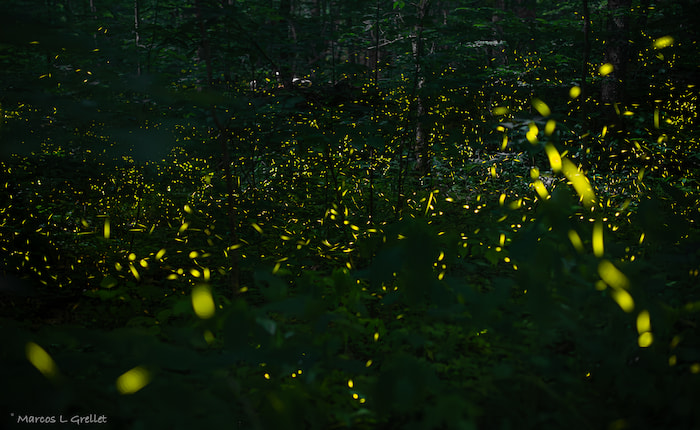
Glowing Success: Conservation Efforts in the Smoky Mountains
While nobody is proposing a return to caveman times, a more conscious use of public lighting could go a long way in providing some relief for these species. Specially designed lampposts could be installed to focus light in a desired direction, thereby preventing leakage to the skies and forests around urban centers. Motion sensors or timers could control outdoor lighting, ensuring that lights are only activated when needed. More dark sky reserves could be created where artificial lighting is strictly regulated to preserve the natural night sky. This could be complemented by redesigning the illumination in natural reserves and parks, particularly those known to harbor fireflies and other animals sensitive to artificial lighting. In some countries, such as the United States, such efforts have proven fruitful. In the Great Smoky Mountains National Park, for instance, public illumination alongside roads bordering the park has been altered and, in some cases, even completely removed. This has improved firefly numbers and consequently fostered a healthier tourism industry around the fireflies’ synchronization spectacle that can only be observed in a few places around the world.
A Night to Remember: Photographing the Smoky Mountains Firefly Extravaganza
Under the sound of thunder tumbling down the valley, and already well into the night, the last few male fireflies – now all out of sync like my ancient Christmas lights – disappear into the dark patches below the tree trunks. They emit a faint pulse as they do, almost like a farewell note. Tomorrow, the light show will commence anew, giving the still-single males another chance to find a mate. The whole spectacle tends to last between eight and fourteen days and usually begins in the first weeks of June, depending on the weather conditions. A handful of teenagers, the odd photographer, and a few grandfathers with grandchildren in their arms walk downwards the kilometre-and-a-half gravel trail that separates the motorhomes — for those who have secured a reservation at the Elkmont Campground — and the tram-like looking bus organized by the Gatlinburg government that brings tourists from the city to the campground.
Loose bits of red cellophane flutter in the breeze down the valley and over the river, one by one disappearing into the darkness. They are biodegradable, and they are few apart. Before long, the forest is once again in silence, as the more adventures of us return to campsites deep within the park and huddle around a fire. As the fire struggles to revolt —fire must be a revolt of nature— over the soggy branches, we all share our lack of words trying to describe what we just witnessed. To no avail. Tired and lost for words, we return to our tents.

